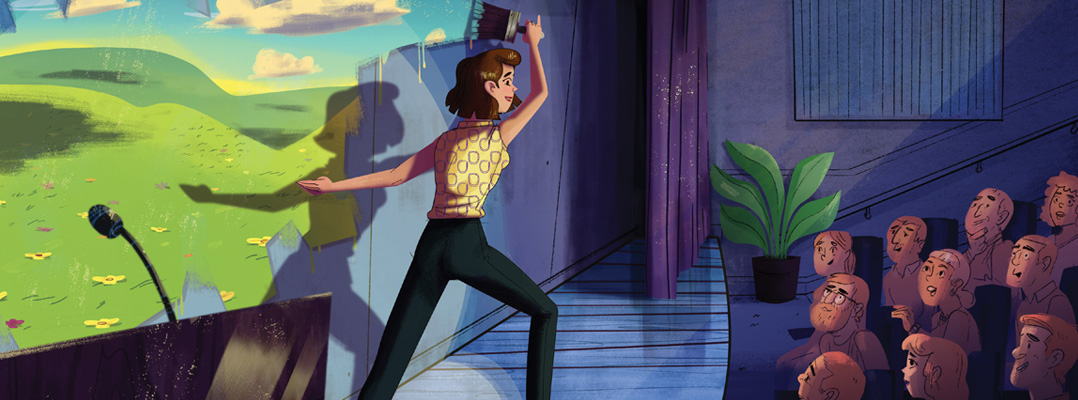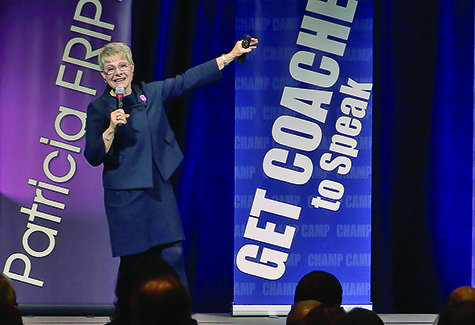Emotion Reigns
How passionate storytelling makes a message unforgettable.

This article is from the August 2016 edition of the Toastmaster magazine.
I was speaking to a group of hotel managers in a program on how to motivate their employees to provide better customer service. In the opening, I pointed out that according to a 2016 Gallup poll, only 34.1 percent of American workers are engaged in the workplace.
And then I told them a story. It was about a woman I had heard singing as she worked in a hospital, and how I had heard her voice all the way from the parking lot. “Some sweet morning, when this day is over, I’ll fly away.”
They were loud, staccato, jubilant notes of a life well lived. When the automatic glass doors to the building opened, I could see her standing there holding her mop as if it were a beloved dance partner, as if her faded cotton dress were made of the finest silk. I watched her all throughout the day as she touched the lives of many. In the cold antiseptic corners of that hospital I saw pain find healing, watched sorrow meet comfort, and saw hopelessness find hope all wrapped up in a faded cotton dress and comfortable shoes. That day, a woman full of blessings who smelled of bleach showed me what service looks like—and it didn’t come in a list, but in an attitude.
The program continued on, and at the end I asked my audience who among them could remember what I had mentioned earlier about the poll and the percentage of employees it indicated were engaged in the workplace. Two hands went up. Then I asked if anyone could remember the song the woman in my story was singing. Almost every hand went up. Nobody could remember the fact, but everyone remembered the story. That showed me how facts aren’t tied to emotions—but story is. It is the greatest tool we have to connect and engage.
Are all stories equal? No. I’ve watched speakers tell stories that captivated the entire room, and I watched them tell stories that put everybody to sleep. Just having a story is not good enough. Apply the following tips to your stories and watch what happens.
Understand how and why story works
Once you understand the psychology behind stories and their impact, it gets easier to write the ones that are most effective for you. It starts with an understanding that listeners don’t take action without first having a visual. Therefore, their thoughts are not stored as words, but as images.
For your data to have a lasting impact, it must be wrapped in an image for the listener to truly connect with, store and access later. The story does all the work. The point drives it home. Story trumps data.
Stop looking for a good story
So many speakers ask, “Is this a good story?” That’s the wrong question. Don’t go looking for a “good” story. Look for one that your audience will connect with. An experience they can relate to. Then work on making it a good story.
Meridith Elliott Powell is a professional business speaker who uses stories as part of her presentations. “Stories are more powerful when you are not always the hero in the story,” she says. “Your audiences learn so much more when they can relate to you. So when you are vulnerable in the story—when you are the one learning rather than teaching the lesson—it has far more impact.” Look for stories that make a connection and make them good.
Craft a good script and a good delivery
Every story has two major components—a stellar script and an awesome delivery. You can’t have one without the other. Every word makes a difference with its ability to add power or take it away. Every gesture, pause, voice inflection and expression has that same power. Use it. Don’t wing it.
Show; don’t tell
A story is as powerful as its details. These details paint the scene and the characters. The details you share (the character descriptions, accents, sounds and smells) allow the listener to step into your story instead of just hearing about it. If the listener can’t see the scene, they can’t connect with it. They want specifics, not generalizations. Don’t speak about how hard it was for you in the 80s. Talk about a specific moment in time when something happened.
Less is more
Telling a story in five to seven minutes is a challenging task and worth the labor, because it forces you to choose the words that count. Like songs, our stories should be tight—every word chosen should serve a purpose—every word should audition its way in. Treat every word like it’s a note in your song.
Act it out
The most common mistake speakers make is that they tell the story like they are reading a grocery list. Don’t step outside of your story and simply talk about it. Stand inside of it and live it again. Act it out whenever you can. Don’t plan gestures to match your story, just be expressive when you tell it. We do this naturally when we tell stories to our friends and family. It’s when we get onstage that we become stiff and unnatural. Tell a story in the same comfortable manner you would have if you were sitting at the kitchen table (without the ums and uhs). Relive the story as you tell it.
Author Bio
Kelly Swanson is an award-winning storyteller, comedian, motivational speaker and author. She teaches the art of connection and engagement through the power of story. Visit www.StoryCraftingCamp.com.
"Don’t step outside of your story and simply talk about it. Stand inside of it and live it again. "


